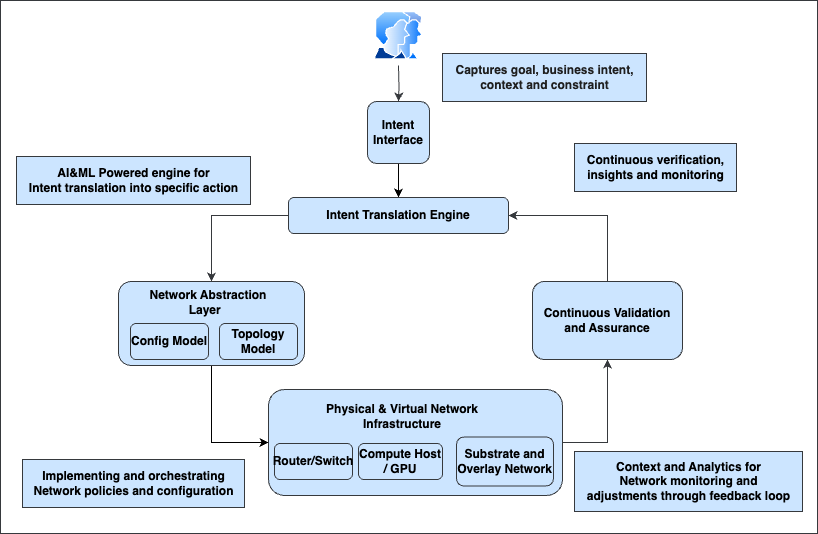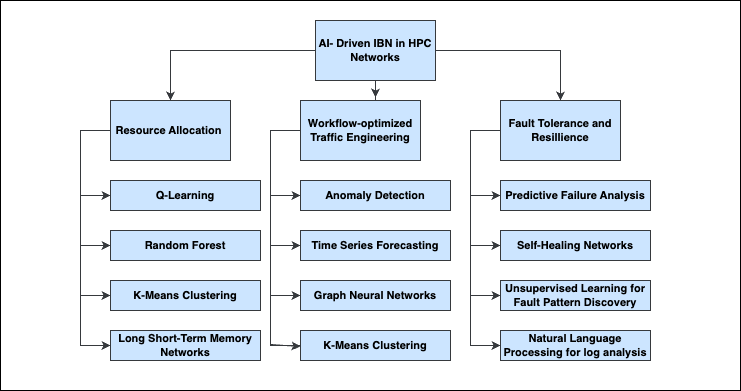AI-Driven Intent-Based Networking: The Future of Network Management Using AI
In this article, explore AI-driven intent-based networking (IBN) as a solution to manage increasingly complex networks.
Join the DZone community and get the full member experience.
Join For FreeWe are living in a world where the internet is an inseparable part of our lives, and with the growth of Cloud computing and increased demand for AI/ML-based applications, the demand for network capacity is unstoppable. As networks scale exponentially, classical topologies and designs are struggling to keep in sync with the rapidly evolving demands of the modern IT infrastructure. Network management is getting complex due to the sheer amount of network infrastructure and links. AI-driven intent-based networking emerges as a potential solution, promising to reshape our approach to network management — but is it truly the solution to this problem it claims to be? Let’s dive into its details to understand how intent-based networking will be shaping the future of network management.
What Is Intent-Based Networking?
Traditional intent-based networking (IBN) evolved from software-defined networking (SDN). SDN is a very popular approach in network automation where software-defined controllers and APIs communicate with the physical Infrastructure. IBN is a natural progression of SDN that combines intelligence, analytics, machine learning, and orchestration to automate network management. It translates high-level business intent into network policies to configure the underlying network. IBN abstracts the complex part of underlying hardware, and network configuration to allow users to express their desired intent in natural language.
AI-driven IBN brings together intelligence, analytics, machine learning, and orchestration to enhance traditional IBN capabilities. It can translate these intents into specific network configurations and policies more effectively, adapting to changing network conditions and requirements. Most modern, advanced IBN solutions do include ML and NLP to some degree making them AI-driven.
|
Problem Statement: The user wants to balance bulk data transfer and low-latency traffic using available bandwidth. |
|
Intent: “Provision low latency for high-performance computing and GPU-accelerated database queries while supporting large dataset transfers.” |
|
Network automation with AI-driven IBN:
|
Key Components of Traditional IBN Systems
To understand the advancements of AI-driven IBN, let's first examine the key components of a traditional IBN system. In a traditional IBN setup, the system consists of five main components that allow users to interact with the system and for the system to devise actions and implement changes in the network based on user intent.

AI-driven Intent-Based Networking
Intent Interface
It’s a primary point of interaction between users and the IBN system. Network administrators and users can express their desired network configuration in natural language, eliminating its dependency on complex CLI commands and manual configurations. In traditional IBN, this interface typically relies on predefined templates and rule-based interpretation of user inputs.
Intent Translation Engine
This is the heart of the IBN where business intent is processed through advanced algorithms, and techniques and translated into actionable network configurations and policies. It bridges the gap between human-understandable intents and machine-executable network configurations. Traditional IBN systems use predetermined algorithms and logic trees for this translation process.
Network Abstraction Layer
This layer provides a unified view of the network, abstracting the underlying complexity of network infrastructure and protocols. It enables the IBN system to work seamlessly with heterogeneous network infrastructures. This abstraction in traditional IBN is often static and may require manual updates to accommodate new network elements or configurations
Automation and Orchestration Engine
This layer implements translated intents across network infrastructure and leverages software-defined networking to update network configuration and policies. In traditional IBN, this automation is based on predefined scripts and workflows.
Continuous Validation and Assurance
This feedback loop constantly monitors the network to ensure it follows the requested intent and makes necessary adjustments to maintain optimal performance. Traditional IBN systems perform this validation based on set thresholds and predefined performance metrics.
The Role of AI in IBN
Integration of AI with traditional Intent-Based Networking allows the system to understand, process, and execute high-level intents without reliance on complex CLI commands, or manual configurations and provides greater flexibility in network management. In this section, we will discuss how AI enhances Intent-Based Networking capabilities and automates network management tasks.
The field of AI consists of various subfields such as Natural Language Processing (NLP), Machine Learning (ML), computer vision (CV), and robotics, among others. NLP allows systems to understand and process human language, while ML allows systems to learn from data without explicit programming. These and other AI subfields working with each other help us build intelligent systems.
NLP and ML play a significant role in AI-driven IBN by giving the system the ability to understand and execute high-level intents.
Natural Language Processing (NLP)
NLP serves as the primary interface between network users and the IBN system. NLP allows users to express their intents in natural language and translate it into complex network configurations. Key applications of NLP in IIBN consist of intent translation, context understanding and processing, and automated network config generation.
Machine Learning (ML)
In AI-driven IBN, ML algorithms allow us to learn from the current network state, predict future states based on the topology and network changes, and make intelligent decisions for network optimization. One of the key applications of ML in IBN is traffic engineering where service providers aim to understand the network behavior, predict the future state, and adjust the network capacity and resources optimally and efficiently.
AI-driven IBN is an intelligent system that incorporates both NLP, ML, and other AI subfields to provide the central framework for decision-making and problem-solving in IBN. It enables automated network design, network data analysis, intelligent troubleshooting, policy enforcement, and forecasting of potential failure scenarios.
Application in High-Performance Computing Networks
AI-driven IBN is a promising solution for hyper-scalar cloud providers who offer High-Performance Computing (HPC) environments, where the demands for high throughput, low latency, flexibility, and resource optimization are especially stringent. Some key applications include:
Dynamic Resource Allocation
In HPC, AI-driven IBN systems use algorithms such as Q-Learning and Random Forests to allocate network resources optimally by analyzing and predicting the current and future resource demand. These systems can bring flexibility and efficiency by utilizing HPC resources optimally and maximizing performance and network throughput.
Workflow-Optimized Traffic Engineering
AI-driven IBN systems can continuously analyze the current and future network state and demand to optimize network configurations. This is done by using Time Series Forecasting (e.g., ARIMA, Prophet) for traffic prediction, and anomaly detection algorithms for identifying unusual traffic patterns. The network configuration optimization might involve shifting traffic from a congested primary path to a secondary path, finding high-bandwidth paths for data transfer stages and low-latency paths for distributed computing stages.
Fault Tolerance and Resilience
IBN systems can predict and simulate potential failures for hardware resources and take proactive action to avoid catastrophic failures. It can triage, auto-mitigate, and remediate the events without interrupting network performance and service. To achieve this, IBN systems employ various algorithms and techniques. Predictive Failure Analysis using machine learning models like Random Forests or Support Vector Machines helps identify potential hardware failures before they occur. Self-healing networks leveraging reinforcement learning algorithms automatically reconfigure network paths when issues arise. These algorithms work together within the IBN framework to maintain robust network performance even in challenging conditions.

AI-driven IBN in high-performance computing networks
Challenges and Future Directions
The availability of sufficient, good-quality data can be the first hurdle that companies have to overcome to be able to implement AI-driven IBN.
- The black-box nature of some AI/ ML models can lead to opaque decision-making making which needs to be overcome by making these processes transparent and understandable.
- Enterprise networks are complex and diverse in terms of hardware, configuration, and protocols; managing such enormous network infrastructure requires a lot of computational resources and power.
- Integration of IBN systems with existing network infrastructure and automation framework
- Complying with the security standards, polices and authentication becomes challenging with the scale and complexity.
- Ensuring IBN systems can make decisions and implement changes quickly enough to meet the performance requirements of modern networks
As AI-driven IBN systems mature, we can expect to see increased network automation, enhanced machine learning algorithms, improved security, and greater efficiency in network management. However, realizing this future will require overcoming these challenges and addressing the skill gap in the networking industry.
Conclusion
AI-driven intent-based networking represents a significant advancement in how service providers can operate and manage their complex networks. With the integration of AI into IBN, users can navigate through this complexity, bring operational efficiency, get real-time visibility, and automate network management to bring the network state in sync with the business intent. The future of networking lies in the system that can analyze, interpret, process human intents, and achieve network autonomy by transforming network operations through intent-based networking.
Opinions expressed by DZone contributors are their own.

Comments